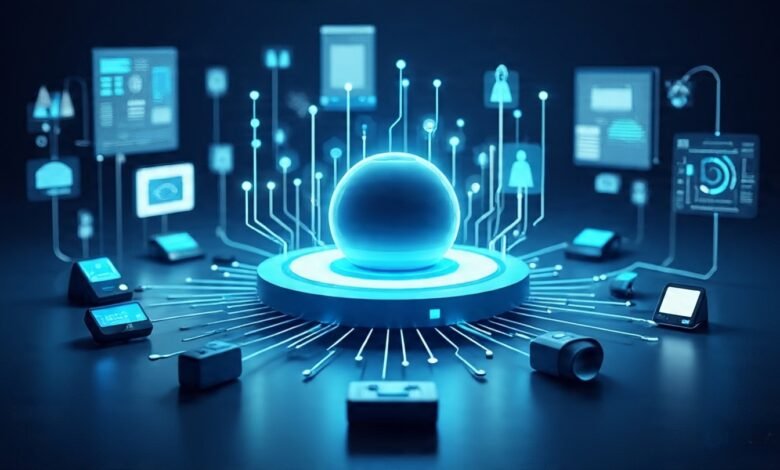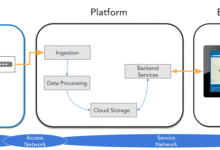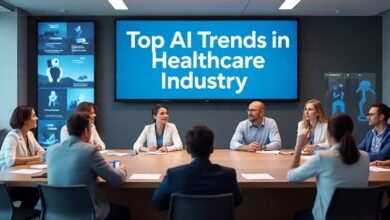
The convergence of artificial intelligence and the Internet of Things (IoT) represents one of the most transformative technological developments of our time, creating what industry experts call the Artificial Intelligence of Things (AIoT). This powerful fusion is revolutionizing how devices interact, process data, and make autonomous decisions across countless industries, from smart homes and healthcare to manufacturing and urban infrastructure.
The rapid expansion of IoT devices has created an unprecedented volume of data that requires intelligent processing and analysis. According to recent forecasts, the number of IoT devices worldwide is expected to grow from 15.9 billion in 2023 to more than 32.1 billion by 2030, generating massive amounts of data that traditional processing methods cannot handle efficiently. This is where artificial intelligence becomes crucial, transforming raw sensor data into actionable insights and enabling smart devices to operate with human-like intelligence.
AIoT integration goes beyond simple data collection and transmission. It empowers devices with machine learning capabilities, predictive analytics, and real-time decision-making abilities that can operate autonomously without constant human intervention. From edge computing solutions that process data locally to cloud-based AI systems that provide comprehensive analysis, this technological marriage is creating smarter, more efficient, and more responsive IoT ecosystems.
The applications of AI-enhanced IoT span virtually every sector imaginable. In healthcare, IoT sensors combined with AI algorithms can monitor patient vital signs and predict health emergencies before they occur. In manufacturing, predictive maintenance powered by AI can prevent costly equipment failures and optimize production efficiency. Smart cities leverage AIoT to manage traffic flow, reduce energy consumption, and improve public safety through intelligent automation.
This comprehensive guide explores how artificial intelligence enhances the Internet of Things, examining the key technologies, benefits, challenges, and real-world applications that are shaping our connected future. We’ll delve into the specific ways AI transforms traditional IoT systems, the role of edge computing in enabling real-time processing, and the emerging trends that will define the next generation of smart, interconnected devices.
Understanding the Fundamentals of AI and IoT Integration
What is AIoT (Artificial Intelligence of Things)?
AIoT, or the Artificial Intelligence of Things, represents the seamless integration of artificial intelligence technologies with IoT infrastructure. This convergence creates systems where IoT devices such as sensors, actuators, and appliances collect, exchange, and process data to meet user goals effectively, while AI processes and analyzes the large volume of data to enhance decision-making processes and overall efficiency.
Unlike traditional IoT systems that primarily focus on data collection and transmission, AIoT systems incorporate machine learning algorithms, natural language processing, and predictive analytics directly into the device ecosystem. This integration enables smart devices to learn from patterns, adapt to changing conditions, and make autonomous decisions without requiring constant cloud connectivity or human intervention.
Core Components of AI-Enhanced IoT Systems
AI-enhanced IoT systems consist of several interconnected components that work together to create intelligent, responsive networks:
Smart Sensors and Actuators form the foundation of any AIoT system. These devices not only collect environmental data but also incorporate machine learning capabilities that allow them to filter relevant information, detect anomalies, and trigger appropriate responses. For instance, an AI-enabled camera sensor captures only frames with meaningful insights like desired objects or anomalies, rather than sending every frame to storage.
Edge Computing Infrastructure plays a crucial role in AI IoT integration by processing data locally rather than sending it to distant cloud servers. This approach reduces latency, improves real-time decision-making, and enhances system reliability by reducing dependence on internet connectivity.
Machine Learning Models embedded within the system enable predictive analytics, pattern recognition, and intelligent automation. These models continuously learn from incoming data, improving their accuracy and effectiveness over time.
Connectivity Technologies ensure seamless communication between devices, edge nodes, and cloud systems. Advanced networking protocols support both time-sensitive local communications and broader data sharing requirements.
The Role of Machine Learning in IoT Enhancement
Machine learning serves as the brain of AI-enhanced IoT systems, enabling devices to process information intelligently and make informed decisions. Six general tasks of AI in IoT systems have been identified: pattern recognition, decision support, decision-making and acting, prediction, data management, and human interaction.
Pattern recognition allows IoT devices to identify trends, anomalies, and recurring behaviors in data streams. This capability is essential for applications like fraud detection, quality control, and predictive maintenance. Decision support systems provide recommendations based on data analysis, while autonomous decision-making enables devices to act independently when specific conditions are met.
Predictive analytics represents one of the most valuable applications of machine learning in IoT. By analyzing historical data and identifying patterns, AI algorithms can forecast equipment failures, predict maintenance needs, and optimize resource allocation. This proactive approach significantly reduces operational costs and improves system reliability.
Key Technologies Enabling AI-IoT Convergence
Edge Computing and Real-Time Processing
Edge computing has emerged as a critical enabler of AI IoT integration, bringing computational power closer to where data is generated. With edge-driven AIoT, devices can analyze and act on data instantly without sending it elsewhere, making split-second decisions without cloud communication delays. This local processing capability is essential for applications requiring immediate responses, such as autonomous vehicles, industrial automation, and emergency response systems.
The benefits of edge computing in AIoT extend beyond reduced latency. By processing data locally, edge devices can operate even when internet connectivity is limited or unavailable. This reliability is crucial for mission-critical applications in remote locations or environments where network interruptions are common.
Edge AI also improves data privacy and security by keeping sensitive information local rather than transmitting it to external cloud servers. This approach is particularly important in healthcare, financial services, and other industries with strict data protection requirements.
Machine Learning Algorithms for IoT Data Processing
Different machine learning algorithms serve various purposes in AI-enhanced IoT systems. Supervised learning algorithms excel at classification and prediction tasks when historical labeled data is available. These algorithms can predict equipment failures, classify sensor readings, and identify optimal operating parameters.
Unsupervised learning algorithms are valuable for discovering hidden patterns in IoT data without prior knowledge of expected outcomes. These techniques can identify unusual behavior, cluster similar devices or conditions, and detect anomalies that might indicate security threats or system malfunctions.
Reinforcement learning enables IoT devices to learn optimal behaviors through trial and error interactions with their environment. This approach is particularly effective for intelligent automation tasks where devices must adapt to changing conditions and optimize their performance over time.
Natural Language Processing and Human-Machine Interaction
Natural language processing (NLP) technologies are transforming how humans interact with IoT devices. Voice assistants, chatbots, and conversational interfaces make smart devices more accessible and user-friendly. NLP enables devices to understand spoken commands, process text input, and provide natural language responses.
Advanced NLP capabilities allow AIoT systems to analyze unstructured data from sources like social media, maintenance reports, and customer feedback. This analysis provides valuable insights that complement traditional sensor data, creating a more comprehensive understanding of system performance and user satisfaction.
Real-World Applications and Industry Use Cases
Smart Manufacturing and Industrial IoT
The manufacturing industry has embraced AI-enhanced IoT to create more efficient, flexible, and responsive production systems. Industrial IoT (IIoT) combined with artificial intelligence enables manufacturers to implement predictive maintenance strategies, optimize production processes, and improve quality control.
Predictive maintenance represents one of the most successful applications of AIoT in manufacturing. AI intelligence can predict equipment maintenance needs in real-time, allowing systems to be shut down or alert for action to prevent damage, potentially saving millions of dollars for companies. Machine learning algorithms analyze sensor data from equipment to identify early warning signs of potential failures, enabling proactive maintenance that reduces downtime and extends equipment life.
Quality control systems powered by AI and IoT can detect defects and anomalies in real-time during the production process. Computer vision algorithms analyze images from cameras positioned along production lines, identifying quality issues that human inspectors might miss. This automated inspection capability improves product quality while reducing labor costs.
Supply chain optimization benefits significantly from AIoT integration. Smart sensors track inventory levels, monitor environmental conditions during transportation, and predict demand patterns. This visibility enables manufacturers to optimize inventory management, reduce waste, and respond quickly to changing market demands.
Healthcare and Medical IoT Applications
The healthcare industry is experiencing a transformation through AI-enhanced IoT applications that improve patient care, reduce costs, and enable new treatment approaches. The combination of IoT, AI, and Machine Learning is enabling clinicians to interpret patient’s biometric data and identify health warnings faster than ever before.
Remote patient monitoring systems use IoT sensors to continuously track vital signs, medication adherence, and other health metrics. AI algorithms analyze this data to detect early warning signs of health deterioration, enabling timely interventions that can prevent hospitalizations and improve patient outcomes.
Wearable health devices equipped with machine learning capabilities can monitor heart rhythms, detect falls, and track physical activity patterns. These devices provide personalized health insights and alerts, empowering patients to take a more active role in managing their health.
Hospital asset management benefits from AIoT systems that track the location and status of medical equipment, ensuring that critical devices are available when needed. Predictive analytics can forecast equipment maintenance needs and optimize resource allocation across healthcare facilities.
Smart Cities and Urban Infrastructure
Smart city initiatives leverage AI-enhanced IoT to address urban challenges and improve the quality of life for residents. These applications demonstrate the scalability and versatility of AIoT technology in complex, large-scale deployments.
Traffic management systems use IoT sensors and AI algorithms to monitor traffic flow, optimize signal timing, and reduce congestion. Real-time data processing enables dynamic adjustments to traffic patterns, improving mobility and reducing emissions from vehicles stuck in traffic.
Energy management in smart cities relies on AIoT systems to optimize power distribution, integrate renewable energy sources, and reduce overall energy consumption. Smart grids use predictive analytics to forecast energy demand and automatically balance supply and demand across the electrical network.
Public safety applications include intelligent surveillance systems that can identify suspicious behavior, detect emergencies, and coordinate emergency response efforts. These systems combine video analytics, sensor data, and machine learning to provide comprehensive situational awareness for law enforcement and emergency services.
Agriculture and Precision Farming
Precision agriculture represents another promising application area for AI-enhanced IoT technology. Farmers use smart sensors to monitor soil conditions, weather patterns, and crop health, while AI algorithms provide insights that optimize farming practices and improve yields.
Soil monitoring systems equipped with IoT sensors measure moisture levels, nutrient content, and pH values. Machine learning algorithms analyze this data to determine optimal irrigation schedules, fertilizer applications, and planting strategies for specific field conditions.
Crop health monitoring uses drones equipped with cameras and sensors to capture images of fields. Computer vision algorithms analyze these images to identify pest infestations, disease outbreaks, and nutrient deficiencies, enabling targeted interventions that improve crop health while reducing the use of pesticides and fertilizers.
Livestock monitoring systems track animal health, behavior, and location using IoT devices attached to or implanted in animals. AI algorithms can detect early signs of illness, monitor reproductive cycles, and optimize feeding schedules to improve animal welfare and productivity.
Benefits of AI-Enhanced IoT Systems
Improved Operational Efficiency
AI-enhanced IoT systems significantly improve operational efficiency across industries by automating routine tasks, optimizing resource utilization, and reducing human intervention requirements. AI cuts down on manual work while improving accuracy, automating keyword research, streamlining content creation, and speeding up technical checks – a principle that applies broadly to IoT operations.
Automated decision-making capabilities enable smart devices to respond to changing conditions without human oversight. This automation reduces response times, minimizes errors, and ensures consistent performance even during off-hours or in remote locations where human supervision is impractical.
Resource optimization through predictive analytics helps organizations reduce waste and improve efficiency. AI algorithms can predict demand patterns, optimize inventory levels, and schedule maintenance activities to minimize disruption to operations.
Enhanced Data Analytics and Insights
The integration of artificial intelligence with IoT systems transforms raw sensor data into valuable business insights. Machine learning algorithms can identify patterns and correlations in data that would be impossible for humans to detect manually, providing deeper understanding of system performance and user behavior.
Real-time analytics capabilities enable immediate responses to changing conditions. Whether it’s adjusting manufacturing parameters based on quality measurements or rerouting traffic based on congestion patterns, AI-enhanced IoT systems can react instantly to optimize performance.
Predictive insights help organizations make proactive decisions rather than reactive responses. By forecasting future conditions and potential issues, AIoT systems enable better planning and risk management across all aspects of operations.
Cost Reduction and ROI Improvement
AI-enhanced IoT implementations typically deliver significant cost savings through multiple mechanisms. Predictive maintenance alone can reduce maintenance costs by 25-30% while extending equipment life by 20-40%, according to industry studies.
Energy optimization through intelligent automation can reduce energy consumption by 10-20% in commercial buildings and industrial facilities. Smart HVAC systems, lighting controls, and equipment scheduling all contribute to these savings.
Labor cost reduction occurs as AIoT systems automate routine monitoring, inspection, and control tasks. This automation allows human workers to focus on higher-value activities while reducing the need for 24/7 human supervision of automated systems.
Scalability and Flexibility
AI-enhanced IoT architectures provide excellent scalability, allowing organizations to start with small deployments and expand as needs grow. Edge computing capabilities enable distributed processing that scales horizontally as more devices are added to the network.
Modular system design allows organizations to add new capabilities and integrate additional devices without disrupting existing operations. This flexibility is particularly valuable in dynamic environments where requirements change frequently.
Cloud integration provides unlimited scalability for data storage and processing, enabling organizations to handle growing data volumes without significant infrastructure investments.
Challenges and Considerations
Security and Privacy Concerns
Security represents one of the most significant challenges in AI-enhanced IoT implementations. The distributed nature of IoT networks creates multiple potential attack vectors, while the integration of AI systems adds additional complexity to security management.
Device security requires robust authentication, encryption, and access control mechanisms. Many IoT devices have limited computational resources, making it challenging to implement comprehensive security measures without impacting performance.
Data privacy concerns arise from the extensive data collection capabilities of AIoT systems. Organizations must implement privacy-by-design principles and comply with regulations like GDPR and CCPA while still extracting value from the data.
AI security introduces unique challenges, including adversarial attacks on machine learning models, data poisoning, and model theft. These threats require specialized security measures beyond traditional cybersecurity approaches.
Integration and Interoperability Issues
Interoperability remains a significant challenge in AI-enhanced IoT deployments, particularly when integrating devices from multiple vendors. IoT devices from different manufacturers often use different standards and protocols, making it difficult for them to perform machine-to-machine communication.
Legacy system integration poses additional challenges as organizations seek to incorporate AIoT capabilities into existing infrastructure. Compatibility issues, data format differences, and communication protocol mismatches can complicate integration efforts.
Standardization efforts are ongoing to address these challenges, but the rapid pace of technological development often outpaces standardization processes, creating temporary compatibility issues.
Technical Complexity and Skills Gap
The implementation of AI-enhanced IoT systems requires expertise in multiple technical domains, including machine learning, edge computing, networking, and domain-specific knowledge. This multidisciplinary requirement creates challenges in finding qualified personnel and managing complex projects.
Skills gap in AI and IoT technologies limits the ability of many organizations to fully leverage these capabilities. Training existing staff or recruiting new talent with the necessary expertise can be time-consuming and expensive.
System complexity increases as AIoT systems incorporate more sophisticated AI capabilities and integrate with existing systems. Managing this complexity requires careful planning, robust testing procedures, and ongoing maintenance capabilities.
Future Trends and Developments
5G and Advanced Connectivity
The rollout of 5G networks will significantly enhance AI-enhanced IoT capabilities by providing higher bandwidth, lower latency, and support for massive device connectivity. These improvements will enable new applications that require real-time communication between large numbers of devices.
Network slicing capabilities in 5G will allow AIoT applications to receive dedicated network resources with guaranteed performance characteristics. This feature is particularly important for mission-critical applications in healthcare, autonomous vehicles, and industrial automation.
Enhanced mobile broadband will support more sophisticated AI algorithms running on mobile and edge devices, expanding the capabilities of smart devices in remote locations.
Advanced AI Technologies
Deep learning and neural network technologies continue to advance, enabling more sophisticated AI capabilities in IoT devices. These improvements will support more complex decision-making, better pattern recognition, and enhanced autonomous operation.
Federated learning approaches will enable AIoT systems to improve their performance by sharing learning experiences across multiple devices while maintaining data privacy. This collaborative learning approach will accelerate AI model improvement without centralizing sensitive data.
Neuromorphic computing technologies designed to mimic brain function will provide more efficient AI processing capabilities for edge devices, enabling sophisticated AI functionality with lower power consumption.
Sustainability and Green IoT
Environmental sustainability is becoming increasingly important in AI-enhanced IoT deployments. Organizations are focusing on reducing energy consumption, extending device lifespans, and minimizing electronic waste.
Energy-efficient AI algorithms are being developed to reduce the computational requirements of machine learning models without sacrificing performance. These optimizations are particularly important for battery-powered IoT devices.
Sustainable manufacturing practices for IoT devices include using recycled materials, designing for disassembly and repair, and implementing take-back programs for end-of-life devices.
Implementation Best Practices
Strategic Planning and Assessment
Successful AI-enhanced IoT implementations begin with thorough strategic planning and assessment of organizational needs, capabilities, and constraints. Organizations should clearly define their objectives, success metrics, and resource requirements before beginning implementation.
Use case identification should focus on applications that provide clear business value and have reasonable implementation complexity. Starting with well-defined, limited-scope projects allows organizations to gain experience and demonstrate value before expanding to more complex applications.
Technology assessment should evaluate available platforms, tools, and vendor solutions against specific requirements. Considerations include scalability, integration capabilities, security features, and long-term support commitments.
Security-by-Design Approach
Security must be integrated into AIoT systems from the initial design phase rather than added as an afterthought. This approach includes secure device provisioning, encrypted communications, regular security updates, and comprehensive monitoring capabilities.
Risk assessment should identify potential security threats and vulnerabilities throughout the system lifecycle. Regular security audits and penetration testing help identify and address security weaknesses before they can be exploited.
Privacy protection measures should comply with relevant regulations and industry standards while enabling the data collection and analysis necessary for AI functionality.
Gradual Deployment and Scaling
Phased implementation approaches reduce risk and allow organizations to learn from early deployments before scaling to larger systems. Pilot projects provide valuable experience and help identify potential issues before they impact larger deployments.
Performance monitoring throughout the deployment process helps identify optimization opportunities and ensures that systems meet performance requirements as they scale.
Change management processes should prepare organizations for the operational changes that accompany AI-enhanced IoT implementations, including new workflows, skill requirements, and maintenance procedures.
Conclusion
The integration of artificial intelligence with the Internet of Things represents a transformative technological advancement that is reshaping industries and creating new possibilities for intelligent automation, predictive analytics, and real-time decision making. AIoT systems combine the data collection capabilities of IoT devices with the analytical power of AI algorithms, creating smart, responsive networks that can adapt to changing conditions and optimize their performance autonomously. From predictive maintenance in manufacturing and remote patient monitoring in healthcare to smart city infrastructure and precision agriculture, AI-enhanced IoT applications demonstrate the technology’s versatility and potential for creating value across diverse sectors. While challenges related to security, interoperability, and technical complexity remain, the benefits of improved efficiency, cost reduction, and enhanced insights make AIoT a compelling investment for forward-thinking organizations. As supporting technologies like 5G networks, edge computing, and advanced machine learning algorithms continue to mature, the capabilities and applications of AI-enhanced IoT will expand further, making this convergence one of the most significant technological developments of our time.











